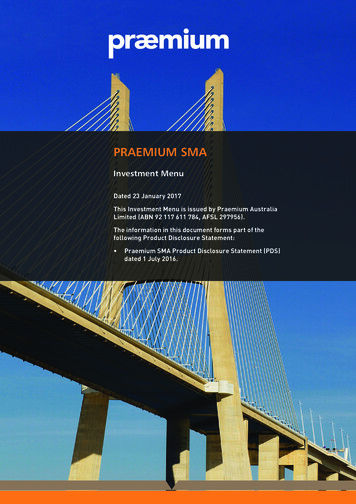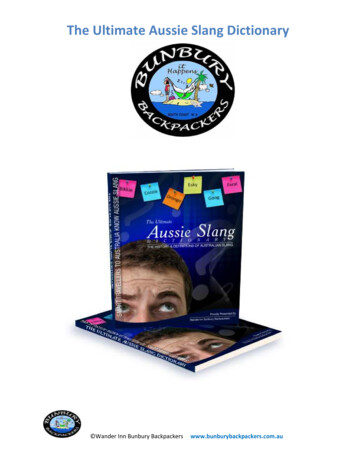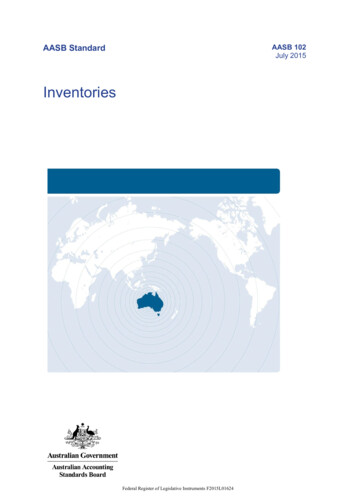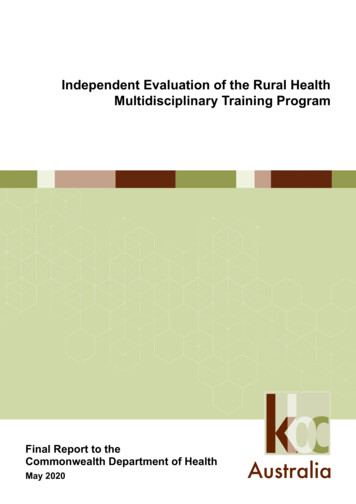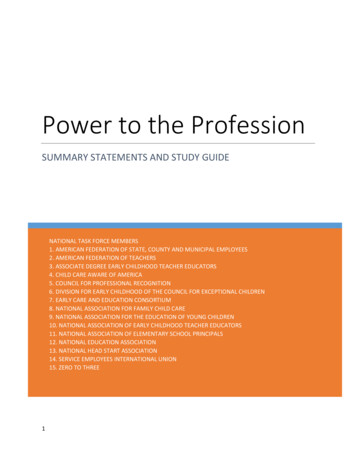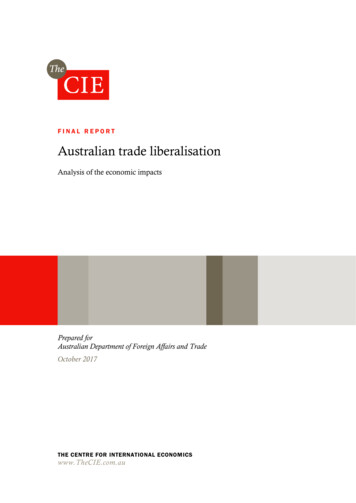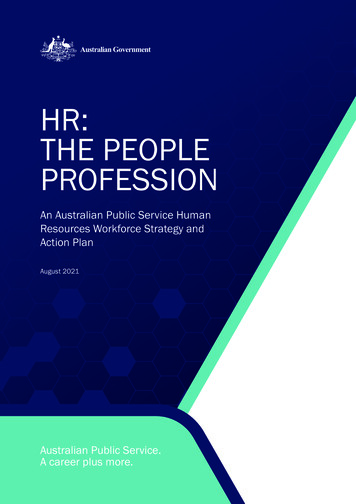
Transcription
HR:THE PEOPLEPROFESSIONAn Australian Public Service HumanResources Workforce Strategy andAction PlanAugust 2021Australian Public Service.A career plus more.
HR Workforce Strategy and Action Planii
August 2021ContentsForeword134678914182122iii
HR Workforce Strategy and Action Planiv
August 2021ForewordColleagues,It is with great pride that I present the AustralianThis strategy is not your usual, high-level document.Public Service’s (APS) first HR Workforce Strategy.We have deliberately created a strategy that is also inThe strategy provides a forward-looking approachparts practical and action-focused, recognising thatto connect HR professionals, grow their capabilities,you will want to know what you can do to translatedevelop rewarding careers, and advance the HRand implement the strategy both for yourself andservice offering for the APS.for your agency. The strategy also recognises thatdifferent agencies are at different points in their HRThe future of the APS relies on the capability,journey. For example, some may already have theiragility and expertise of its people and HR will playown HR workforce strategies, while others will not.a key role in delivering that vision. That means it’sBecause of these differences, the strategy has beentime for us all to take our capability to the nextdesigned to be flexible, with no set timeframe, andlevel. Gone are the days when HR was consideredis to be used as a guiding document. Suggestedsolely as an ‘attract, recruit, and build’ capability.measures of success have also been included inHR nowadays is increasingly recognised for itsAnnex A, noting that agencies should measureimportant role in ensuring the APS has the capacitysuccess in the way that works best for them.to deliver its core services to the community andanticipate the needs of the future.Each and every one of us has a key role to play inimplementing this strategy and taking HR to theThis means our relationships with business arenext level. We are the profession with the power toparamount. To get to the next level, we needsupport and change the APS, but we can only dobusiness to trust us, engage with us early andthat by working together and helping one another.follow our advice. In return, we must prove we trulyThis strategy is one way we can do this. I hope youunderstand the business by giving them timely,find it useful.relevant and strategic advice. We will, of course,still focus on the people aspects of issues,Jacqui Curtisbut we increasingly need to use business skillsHR Head of Professionto help understand what’s important in the widerenvironment, and use that knowledge to ensurewe offer viable solutions for business.1
HR Workforce Strategy and Action Plan“I think there’s still a bit of a mindset that HR is still thattraditional attract, recruit, build capability. Obviously, this ispart of the job, but HR is so much more than just those tasks.In the future, HR needs to be innovative and creative if it’sgoing to be able to deliver on that trusted adviser role that itneeds to be.”Jacqui Curtis, HR Head of ProfessionFebruary 20212
August 2021Continuing HRprofessionalisationThe 2019 Independent Review of the APS identified arange of current and future HR needs for the AustralianPublic Service.It found that many of the recommendationsgenerated from previous reviews, including theUnlocking Potential Review (2016), had not beenimplemented.1 The Independent Reviewre-emphasised the importance of strategiccapability and recommended that the APSdevelop a professions model to lift its coreexpertise, meet long-term capability needs, andprovide rewarding careers.HR and digital and data professions wereimmediate priorities, given the significant demandsthat review implementation would place on the HRprofession and the need to build stronger digitaland data capability. HR professionals play a criticalrole in implementing recommendations from thereview, including a whole-of-service learning anddevelopment strategy and a whole-of-serviceworkforce strategy (Delivering for Tomorrow –APS Workforce Strategy 2025).Following the review, the APS HR ProfessionalStream Strategy was formally launched in 2019by Australian Public Service Commissioner, PeterWoolcott. The Professional Stream Strategyrecognised a need to provide a systemic, servicewide approach to build and uplift strategic HRskills across the APS through the identification ofcapability needs, standards and career pathways.2As such, the APS HR Head of Profession,Jacqui Curtis, and supporting implementationteam have coordinated and implemented a rangeof initiatives to support the capability uplift of theHR workforce.The APS HR Workforce Strategy (this strategy)aims to build on the momentum of that work andguide the next phase of professionalisation. Thisstrategy charts the way for current and futureleaders to successfully build capabilityindividually and across the profession.In turn, this will support the APS to drive greatorganisational outcomes.In developing the strategy, extensive stakeholderengagement was conducted across numerousorganisations, HR functional streams andexperience levels to identify current challenges,gaps and opportunities. Comprehensive desktopresearch activities were undertaken to supportthe development of the strategy.What do we mean byprofessionalisation?A profession is commonly understood as adisciplined group of individuals who adhere tocommon ethical standards.3 The group positionsitself as possessing special knowledge andskills in a widely recognised body of learning.Professionals are governed by codes of ethics,and profess commitment to competence,integrity and promotion of the public good.41Department of the Prime Minister and Cabinet, Independent Review of the Australian Public Service, Canberra, 2019.2Australian Public Service Commission, APS HR Professional Stream Strategy, Canberra, 2021.3Definition from Professions Australia website www.professions.org.au/what-is-a-professional.4 Sylvia R Cruess, Sharon Johnston and Richard L Cruess. “Profession: a working definition for medical educators.”3
HR Workforce Strategy and Action PlanFor members of the APS, the APS Values,the APS Employment Principles and the APS Codeof Conduct set out the standard of behaviourexpected of agency heads and APS employees.As an HR profession, we reinforce these valuesand embody the code of ethics in the work thatwe do.We believe that what makes someone aprofessional is not limited to their skill, knowledgeand qualification level but extends to theattributes, principles and mindsets they hold.Various journal articles and publications writtenover the last decade note that, globally, HR hasmoved further into the realm of professionalism.This is due to a larger emphasis on competencies,the development of formal bodies of HRknowledge, official routes to learning and theintroduction of standards of practice.55For HR, to professionalise is tocreate a collective purpose andcode of behaviour.Teaching and Learning in Medicine (2004): 74-76. SHRM, 2013, ‘Workplace Visions’, place%20visions%20issue%202%20final.pdfCurrent workforce snapshotWHO ARE WE?4.3% 55%WE SUPPORT150,474 employeesACROSS THE APS(APS Employment Data, 30 June 2020 release)of the APS workforce areHR PRACTITIONERS(APS Workforce Strategy 2025, pg 10)of us have aBACHELOR’S DEGREEOR HIGHER(HR Census and APSED Insights, 31 December 2020)HOW WE WORK ACROSS THE APS63%HAVE ONLY WORKEDOF THE PROFESSIONAT ONE AGENCY(HR Census and APSED Insights, 31 December 2020)4MEDIAN LENGTH OF SERVICEFOR THE PROFESSION IS13 YEARS(HR Census and APSED Insights, 31 December 2020)
August 2021Gaps and challengesEmerging challenges include:Research and stakeholder consultation indicatedthat across the APS, many of the currentcapability gaps and workforce challenges inthe HR profession are not necessarily ‘new’ or‘emerging’ but are longstanding. Rising HR complexities in relation to workforcecomposition (e.g. ongoing, non-ongoing,contract, multiple employer, sub-contract). Skillsets in the APS remain in the ‘traditionalist’HR space (such as recruitment, performanceand payroll administration). This createslimitations on the ability to develop modernskillsets, cater for emerging workforce needsand appropriately implement change. Increasing concerns around mental healthand wellbeing across the APS. Workforce capability gaps remain inworkforce analytics, strategic HR,contemporary HR knowledge andcustomer-centred service delivery.Challenges relating to mobility wereidentified by HR practitioners acrossthe APS. The barriers to successfulmobility include geographicalconstraints, unwillingness to releasestaff, lack of backfilling capacity andunclear objectives. Lack of awareness regarding careerprogression opportunities and diversecareer pathways was identified as achallenge for HR professionals. Communicating the value proposition ofHR remains a key challenge for seniorleaders across the APS.OpportunitiesHR offers a diverse number of careers acrossthe APS. These careers are located throughoutAustralia, in both regional and metropolitan areasin all states and territories. HR roles requirea range of qualifications and skill levels, andmany are transferable across organisations,allowing for career flexibility. While traditionalHR occupations are still needed, a number ofnew skillsets are also increasing in demand (e.g.data and network analysis, employee coaching,workplace design and employee wellness).This is due to the shift in HR roles towardsthose that support technological advancement,systems thinking, and sophisticated people andwellbeing management.There are a range of opportunities for theworkforce. Key opportunities include: identifying different pathways toprofessionalisation for HR practitioners building capability in focus areas(current and emerging) consistent and widespread collaborationand information sharing.5
HR Workforce Strategy and Action PlanHR workforce visionOur vision is for the APS HR workforce to have a strongprofessional identity, grounded in shared values and recognisedstandards. As a profession, we aim to create opportunities andworking environments to help our people be their best forboth themselves and the APS.Through the implementation of the APS HR Workforce Strategy over the comingyears, we envision the profession gaining greater capability, reaching further intoand across business, and reinforcing HR’s role as a respected contributor in thestrategic direction setting of the APS.In order to be a trusted APS, united in serving all Australians by 2030,we must invest in HR professionals now to better prepare us for the future.Together we will: seize opportunities to deliver great services foster a dynamic, adaptive and resilient workforce build professionalism and expertise embrace data and digital collaborate to solve problems work together to reduce silos strengthen our leadership capability.The Workforce Strategy supports this vision through its focus on thefollowing three pillars:6 growing individual capability delivering consistent, high-quality services maturing the HR profession.
August 2021Our commitment toprofessionalisationWe value being part of a profession andbenefit from its continued improvement.As the profession matures, commitment toprofessionalisation must be shared across theworkforce. Every person who belongs to theHR profession has a key role in implementingthe strategy.AS AN HR PRACTITIONER,my role is to engage withand support the activitiesof the professional streamand utilise its resources andactivities to continue my ownjourney to professionalisation.We need to reach forward and take action atthe individual and organisational level to driveimprovement across the APS. As individuals werepresent the profession in the actions we take,how we interact with our clients and how weview ourselves. At every level there are ways wecan identify our contribution to the uplift of HRcapability and HR services across the APS.AS AN HR MANAGER,my role is to lead by exampleand motivate staff to engagein communities of practiceand strive for more.AS AN AGENCY LEADER,my role is to work with theAPS HR leadership cohort,to be the drivers of changeand empower people andorganisations to challengeand innovate.AS THE HR PROFESSIONAL STREAM, our role is to come togetherto share knowledge, overcome challenges and collaborate.This strategy serves as a guide for HR professionals. It isdesigned to be practical and useable for all members of theHR workforce, and implementable for all organisationsacross the APS.Throughout the document you will see how the aboveroles contribute to each strategic outcome.We encourage you to find where you fit, where youcan support, and how you can contribute to thefuture of HR within the APS.Annex A provides further details on measuringstrategy success.7
HR Workforce Strategy and Action PlanStrategy pillarsThe strategy links opportunities to be led byindividuals and organisations across the APS.These opportunities are described withinthree pillars.The strategy identifies a range of outcomes underthe three pillars. Together, the stream will seizeopportunities, and improve service outcomes tomeet the HR needs of the future.The pillars are designed to: support individuals to have rewardingHR careers support organisations to build the capabilitiesof their HR professionals support a ‘one HR’ to enable a ‘one APS’.Our pillars1. GROWINGINDIVIDUALCAPABILITYWe will ensure that all HRprofessionals have theopportunity to build theirskills, knowledge andnetworks and are committedto continuing professionaldevelopment.This will help to ensure HRroles are rewarding andour staff are supported torespond to contemporarychallenges.For HR professionals82. DELIVERINGCONSISTENT,HIGH-QUALITY SERVICESWe will build client trust byfocusing on consistency, qualityand strategic problem-solving.We will make it our goal to knowyour business.For organisations3. MATURINGTHE HRPROFESSIONWe will always endeavourto do our best and build ourreputation as a professionalservice. We will build alearning culture and sharebest practice and innovationsacross the APS and beyond.Across the APS
August 2021Pillar 1: Growing individualcapabilityOBJECTIVE STATEMENT 1We will ensure that all HR professionals have the opportunity to build their skills, knowledge andnetworks and are committed to continuing professional development. This will help to ensureHR roles are rewarding and our staff are supported to respond to contemporary challenges.OUTCOME 1.1All HR professionals will have identified their pathway to professionalisation.ACTIVITYImplement the Pathways to Professionalisation Capability Framework.How do you contribute? As an HR practitioner, I will use thePathways to Professionalisation CapabilityFramework to understand my developmentopportunities and map my career andlearning pathway.As an HR manager, I will use the Pathwaysto Professionalisation Capability Frameworkin performance and developmentconversations to plan opportunities forcapability uplift.58%OF HR PRACTITIONERS AGREETHERE IS A SKILL ORCAPABILITY GAPwithin their workgroup(APS Census, 2019) As an agency leader, I will consider thePathways to Professionalisation CapabilityFramework when allocating learning anddevelopment resources to my HR team. Across the APS, we will share and trackimplementation of the Pathways toProfessionalisation Capability Framework.DEVELOPMENTOF HR PROFESSIONALS IS THEBIGGESTBARRIERFOR SUCCESS(APS HR Professional Network Survey, 2021)CONTEMPORARYHR KNOWLEDGE ISTHE MOSTessential (72%)quality for HR professionals(APS HR Professional Network Survey, 2021)9
HR Workforce Strategy and Action Plan“Mobility in the public sector is important. The APS must be morepermeable and mobile in order to foster diversity of thinking,the contestability of ideas and assist in capability development.”APS Commissioner, Peter WoolcottGrowing individual capabilityOUTCOME 1.2HR professionals will be valued for their breadth of HR experience.ACTIVITYLeveraging off the APS Mobility Framework, encourage mobility for HR professionals.How do you contribute? 10As an HR practitioner, I will exploreoptions for short-term secondments andbring my new skills back to my teamand organisation.As an HR manager, I will encourage mystaff to engage in mobility opportunities,and recognise those with a breadth ofexperience when I am recruiting andpromoting staff. As an agency leader, I will promote andenable professionals to pursue mobilityopportunities. Across the APS, we will work with,and leverage off, the APS MobilityFramework to encourage HR specificmobility.
August 2021Growing individual capabilityOUTCOME 1.3We promote a culture of learning and support staff to pursue professionalisation opportunities.ACTIVITYBuild awareness and engagement of HR learning opportunities.How do you contribute? As an HR practitioner, I will use a rangeof mechanisms, such as my performancereview, coaching and mentoring,professional networking and individualand group learning to further develop myknowledge and capability. As an agency leader, I will communicatethe importance of life-long learningto staff. Across the APS, we will continue toevaluate the effectiveness and impactof learning for organisations.As an HR manager, I will provide guidanceto staff members on learning anddevelopment techniques, resourcesand opportunities.Action in focus:A look at HR mobilityHR professionals may wish to explore lateraldevelopment opportunities to gain newexperiences and perspectives. For example,those in small agencies with generalist skills,could explore what it is like to work in largeragencies, amongst professionals who have deepbusiness expertise, and vice versa.A three to twelve month temporary moveprovides time to experience new subject matteror a delivery model. This will also facilitate newpersonal and professional connections.HR mobility should leverage off the progress ofexisting programs and resources as outlined inthe APS Mobility Framework.11
HR Workforce Strategy and Action PlanPillar 1: Action planThe below actions are for individuals, leaders and agencies to incorporate into their own plans forrealising the strategy.Activity 1Implement thePathways toProfessionalisationCapability Framework.HR PROFESSIONAL STREAM& APS LEADERSHIPACTIONS Engage staff and formallylaunch the framework. Build staff awarenessthrough targetedcommunications across theNetwork. Undertake educationto support frameworkutilisation across the APS HRworkforce. Provide information andsupport for integrating theframework into workforceprocesses:Activity 2Leveraging off the APSMobility Framework,encourage mobility forHR professionals.HR PROFESSIONAL STREAM& APS LEADERSHIPACTIONSActivity 3Build awareness andengagement of HRlearningopportunities.SUGGESTED HRORGANISATIONALACTIONS Leverage progress madethrough existing mobilityopportunities (such as theOne APS Opportunitiespilot). Engage with the APSHR Professional Streaminitiatives (e.g. Pathwaysto ProfessionalisationFramework, mobility). Communicate the benefitsof breadth of experience. Identify talent mobilityadvocates (SES) acrossthe workforce.Use the strategy keymessages to buildawareness amongst yourteam of methods andpathways for learning. Work with the APSC tocommunicate mobilityoptions (in line with theAPS Mobility Framework). Communicate opportunitiesfor professionaldevelopment within theHR workforce to potentialrecruits. Use the Pathwaysto ProfessionalisationFramework to showcasethe many careerpathways available for HRprofessionals. Re-assess commitment tolearning and developmentto ensure it aligns withthe profession andorganisational outcomes. Assess and showcasebenefits of learning. recruitment performance capability and careerdevelopmentdiscussions workforce planning mobility and transition. Review framework uptake.Timeframe: 1-3 monthsSUGGESTED HRORGANISATIONAL ACTIONS Proactively engage/reachout to other departments/agencies to set-up andcoordinate mobilityopportunities.Timeframe: 3-6 months /OngoingTimeframe: Ongoing12
August 2021“Finding different experiences, challenging yourself,taking yourself out of your comfort zone, working withdifferent people — all of that leads to better collaboration.It leads to you having good networks. It leads to you beingable to be an interpreter. And that is not only of benefit toyou, it’s absolutely of benefit to the APS.”Helen Wilson, Deputy Australian Statistician,Australian Bureau of StatisticsWhat does success look like?PILLAR 1: OBJECTIVEWe will ensure that all HR professionals have the opportunity to build their skills, knowledge and networksand are committed to continuing professional development. This will help to ensure HR roles are rewardingand our staff are supported to respond to contemporary challenges. HR professionals are proactively broadeningand building their expertise. The narrativeand culture around mobility has shifted andindividuals actively seek out opportunities tobuild their own capability and the capability oftheir organisation. HR professionals have the capabilities torespond to future APS challenges such aschanging resource profiles, variations in HRskillsets, increasing workplace complexity andtechnological advancement or lack thereof. Expertise is purposefully shared acrossthe APS and professional networks areestablished and maintained.Success for our clients looks like: Clients receive contemporary and accurateHR advice at all levels. Lessons from across the APS are sharedand professionals utilise the experience andexpertise in other organisations to respond tochallenges and improve HR service delivery. HR professionals make their development apriority and are supported by organisations,managers and executive.Increased mobility offers new perspectivesand capability to our clients. The broadeningof expertise ensures the HR workforce isbetter equipped to support and manageclient challenges.13
HR Workforce Strategy and Action PlanPillar 2: Delivering consistent,high-quality servicesOBJECTIVE STATEMENT 2We will build client trust by prioritising consistency, quality and strategic problem-solving.We will make it our goal to know your business.OUTCOME 2.1We understand business and our clients understand the HR service offering.Together we meet organisational and APS objectives.ACTIVITYPartner with business to understand drivers and requirements. Using this understanding, set andcommunicate expectations about the HR service offering.How do you contribute? As an HR practitioner, I take the timeto understand business objectives,requirements and challenges. As an agency leader, I will review serviceofferings and operating models to ensurewe meet the needs of clients. As an HR manager, I will work with myclients to develop a joint understanding ofhow HR and business can partner togetherto achieve organisational outcomes. Across the APS, we will support HRto understand and communicate theirservice offerings, including how thismay change.Our client responses:“I want HR practitioners to understand my needsand the needs of the broader business.”“There is a disconnect between HRand business areas.”“I want contemporary, best practiceHR solutions.”14
August 2021Delivering consistent, high-quality servicesOUTCOME 2.2We identify and value a diverse skillset and are preparing our organisation for future challenges.ACTIVITYIdentify and balance capability within the organisation’s HR function.How do you contribute? As an HR practitioner, I will look tobalance my technical HR skills with astrong business understanding. As an agency leader, I will identifywhere I have deep capability andseek to share it with others. As an HR manager, I will know what skillsmy staff possess. I support my team byensuring they have the skills needed nowand into the future. Across the APS, we will supportfoundational capability uplift byfacilitating rollout of a foundationalHR skills program.OUTCOME 2.3We will develop a better understanding of what it means to be strategic in HR.ACTIVITYEstablish a ‘Capability in Focus’ program which will target current capability gaps in strategic HR.How do you contribute? As an HR practitioner, I will engage in theprogram and will adopt a learning mindset. As an HR manager, I will contribute andfree up time to participate in the Capabilityin Focus program. As an agency leader, I will commit toproviding resources for my organisationto participate and encourage robustconversation with colleagues acrossthe service. Across the APS, we will coordinate theprogram by developing a forward work planand identify leaders to support delivery.15
HR Workforce Strategy and Action PlanPillar 2: Action planActivity 1Partner with business tounderstand drivers andrequirements. Using thisunderstanding, set andcommunicate expectationsabout the HR service offering.SUGGESTED HRORGANISATIONALACTIONS SUGGESTED HRORGANISATIONALACTIONS Consult with business areasto understand organisationaldrivers and requirements.Undertake a functional ororganisational review tounderstand where thereare gaps, duplication andinefficiency within theHR service.Once baseline requirementsare identified, explorealternate or improvedoptions for delivery, includingoutsourcing arrangements orshared services. Identify areas for potentialskill transfer and capabilityuplift within business areas. Develop or refresh functionalservices so that businessand HR are clear on whatthe ‘HR service offering’looks like. This will supportexpectation management. Activity 2Identify and balance capabilitywithin the organisation’sHR function.Review and adjust serviceoffering where required.Suggested timeframe:6-12 months fromcommencement.Undertake environmentscanning within and acrossthe APS to understandcurrent and emerging skillrequirements. Leverageoff APSC and APS HRProfessional Streamresources and expertise. Leverage current resourcesor develop framework forskills audit. Conduct a skills auditacross team, functionor organisation levels tounderstand current capability. Review job roles to identifywhere requirements mayneed to be developed,expanded or redefinedto ensure aspects suchas employee experience,wellness and systemssupport are incorporatedinto job descriptions. Build, recruit or outsourceskills following audit.HR PROFESSIONALSTREAMACTIVITIES Leveraging off the HRgraduate modules, developand implement an HRFoundational Skills Package. Monitor and review success.Suggested timeframe:6-12 months fromcommencement.16Activity 3Establish a ‘Capability inFocus’ Program which willtarget current capability gapsin strategic HR.HR PROFESSIONAL STREAM& APS LEADERSHIPACTIONS Tap into existing HRCentres of Excellence. Design a forwardprogram schedule. Plan and coordinateprogram. Deliver practicallearning sessions. Share learnings withinHR organisations. Evaluate programutilisation and benefits.Timeframe: Ongoing
August 2021What does success look like?PILLAR 2: OBJECTIVEWe will build client trust by prioritising consistency, quality and strategic problem-solving.We will make it our goal to know your business. Across the APS, business and HR have ashared understanding of the role of HR andhow they support organisations. A strong, consistent HR foundation has beenachieved across the APS. This will ensure thata baseline HR understanding and service isdelivered to the APS, regardless of individualexperience, work stream or organisation size. HR professionals have a greater awarenessand understanding of current capability gapsand future capability requirements. They aresupported by the stream to continue to buildcapability in these areas. The APS is known as an exemplar of HRservices. Clients are satisfied with theservices provided and the reputation of theHR workforce attracts a range of prospectiveemployees.Success for our clients looks like: Clients partner with HR and receive tailored,best practice solutions. HR professionals understand the complexityof the challenges clients face such as politicalchanges, emerging issues with mental healthand demographic trends. As a profession weare equipped to support the business to meetthese challenges.Action in focus:A look at HR servicesOrganisations should clearly articulate their HR service to ensure collective commitmentto the work we do and the clients we serve. It ensures that both HR professionals andclients know what to expect.The following questions should be considered before communicating your HR services: Have you explicitly identified the organisation's business goals? Are channels of communication clear? Are client standards and responsibilities known? Have you reviewed and considered feedback received? Do you hold staff accountable?17
HR Workforce Strategy and Action PlanPillar 3: Maturing the HRprofessionOBJECTIVE STATEMENT 3We will always endeavour to do our best and build our reputation as a professional service.We will build a learning culture and share best practice and innovations across the APS and beyond.OUTCOME 3.1We will come together, to share ideas and collaborate on areas of increasing complexity,uncertainty and innovation.ACTIVITYCoordinate activities that foster genuine and targeted collaboration, information sharingand networking.How do you contribute? As an HR practitioner, I will actively seek outcollaboration and networking opportunitiesacross the APS. As an agency leader, I will lead by exampleand foster collaborative relationships acrossthe executive cohort. As an HR manager, I will drive collaborationactivities and share my organisation’ssuccesses and lessons learnt. Across the APS, we will support coordinationof collaborative activities.OUTCOME 3.2We will recognise the achievements of our colleagues and advocate the value propositionof HR across the APS.ACTIVITYDevelop mechanisms for recognition of HR excellence.How d
the HR profession are not necessarily 'new' or 'emerging' but are longstanding. Workforce capability gaps remain in workforce analytics, strategic HR, contemporary HR knowledge and customer-centred service delivery. Challenges relating to mobility were identified by HR practitioners across the APS. The barriers to successful



